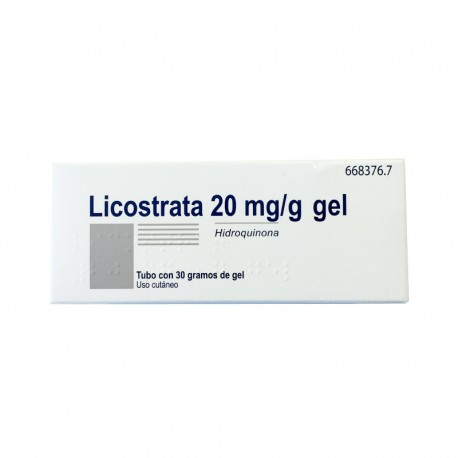

LICOSTRATA 20MG/G Gel. 30Gr.
Action and mechanism
Skin depigmentator. Hydroquinone produces reversible depigmentation of the skin by preventing the metabolic processes of melanocytes. In particular, it inhibits the enzyme tyrosinase, which transforms tyrosine into melanin. Consequently, the structure of the melanosomes is altered, which can cause either a decrease in production or an increase in the degradation of these organelles, or both processes at the same time. Furthermore, it has been proven that hydroquinone induces necrotic effects on the melanocyte, through direct intracellular damage. Hydroquinone only interferes with the formation of new melanin, so the depigmentation effect is not immediate and is only temporary, since that melanin production is reactivated when hydroquinone treatment is interrupted.
Pharmacokinetics
Topical use: The application of hydroquinone on small skin surfaces, its slow absorption through the skin (0.55+-0.13 mcg/cm2/h) and its rapid urinary excretion do not make it foreseeable that absorption could produce systemic effects. .
Indications
[SKIN HYPERPIGMENTATION] such as [MELASMA], senile [LENTIGO] and freckles (ephelides).
Posology
Topical route:
Adults and children over 12 years of age: Apply a small amount of product 2 times a day (morning and night) exclusively on the stain until the desired effect is obtained, which may require several weeks of treatment.
When the 4% gel is administered, the treatment will begin with a single administration per day at night, for 10 or 15 days exclusively on the stain. Then administer 2 times a day
- Duration of treatment: This medication should in no case be used for more than six months. If no improvement is observed after 2 months of treatment, it should be interrupted and the dermatologist should evaluate the clinical situation.
Use of the product should be stopped when the stains disappear.
Interactions
- Peroxides: The simultaneous use of hydroquinone with peroxides (e.g. hydrogen peroxide, benzoyl peroxide, etc.) can produce temporary discoloration of the skin, due to the oxidation of hydroquinone. This temporary discoloration is removed by stopping the use of one of these medications and washing the application area with a mild soap.
Adverse reactions
- Occasionally, [ERYTHEMA], itching and, less frequently, skin sensitization ([SKIN IRRITATION]) may occur. If it were used in very prolonged treatments, a [SKIN HYPERPIGMENTATION] reaction could occur.- Rarely, in prolonged treatments (more than 6 months) and at high doses, [OCCHRONOSIS] has been observed, mainly in black individuals.- In Leukoderma ([VITILIGO]) has been observed in isolated cases. - No systemic adverse effects have been described. - If the appearance of adverse reactions is observed, treatment should be suspended and reported to the pharmacovigilance systems.
Overdose
- Symptoms: Due to its external use, poisoning symptoms are not likely to occur. In case of accidental ingestion, serious manifestations of systemic toxicity similar to those of phenol may occur. Oral ingestion of 5-15 g of hydroquinone produces tremor, seizures, and hemolytic anemia. - Treatment: It is recommended to perform a stomach lavage.
Precautions regarding excipients
- Because it contains butyl hydroxytoluene as an excipient, it may produce local reactions on the skin, such as contact dermatitis, or irritation of the eyes or mucous membranes.
Precautions regarding excipients
- This medicine contains propylene glycol, so it may cause skin irritation.
Contraindications
- Hypersensitivity to hydroquinone or any of the components of the preparation. - On [WOUNDS], mucous membranes, [DERMATITIS] or irritated skin, [SUNBURN]. - Children under 12 years of age, due to the lack of safety and efficacy data. in this population.
Precautions
- External use. Use only on intact skin.- Avoid contact with eyes and mucous membranes. In case of accidental contact with the eyes, wash with plenty of water to avoid the possible production of opaque spots on the cornea. In case of contact with the lips, a bitter taste and a slight anesthetic effect may be noticed.- Apply only to small surfaces. If the pigmented area is very extensive, it should be treated in different cycles.- During treatment with hydroquinone, it is essential to protect the treated area from the sun, since minimal exposure to the sun can reactivate the production of melanin. It is advisable to use during the day a photoprotector with a high protection index.- Wash your hands with soap after applying the product, as hydroquinone can produce reversible brown stains on the nails.- This product cannot be used to prevent sunburn.- In People with very dark skin, the effects of hydroquinone may be less visible.- In some people, especially those with sensitive skin, hypersensitivity reactions may appear. To prevent this, it is advisable to apply a small amount of the product on the inside of the forearm for at least 24 hours. If severe irritation occurs, the use of this product should be discarded. In some cases, a temporary darkening or irritation of the skin may appear; If it persists, treatment should be interrupted.- Depigmentation is not immediate, since hydroquinone only interferes with the formation of new melanin, and it is only temporary, since when treatment is interrupted, melanin production resumes. Depigmentation can be maintained between 2 and 6 months after finishing treatment. The darker the lesions, the sooner they repigment. Although the treatment does not lead to a complete disappearance of the spots, the results are often satisfactory.
Pregnancy
FDA Category C. Animal studies have not revealed teratogenic effects at doses non-toxic to the mothers. The safety of topical hydroquinone use in pregnancy has not been established.
Lactation
The safety of topical use of hydroquinone in nursing mothers has not been established.
Children
Avoid its use in children under 12 years of age, because its safety and effectiveness have not been proven.
Seniors
No specifically geriatric problems are anticipated.
Rules for correct administration
Wash and dry the affected area of skin. To prevent repigmentation of the spots from occurring, the treated area of the skin must be protected from the sun during and after the treatment. This is achieved by applying a high protection factor sunscreen in this area or covering the area with clothing.

